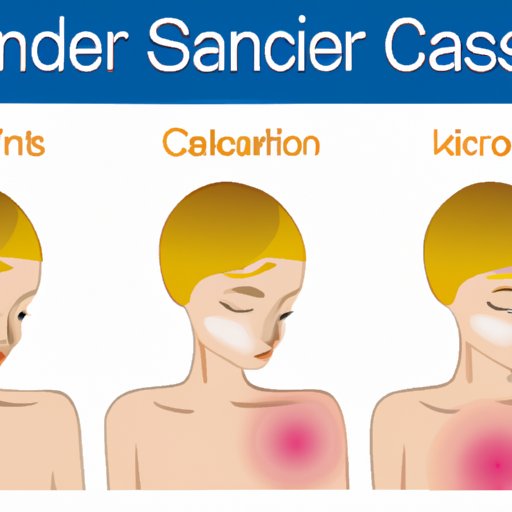
I. Introduction
Skin cancer is one of the most common types of cancer. Identifying symptoms early on can greatly improve chances of successful treatment. In this article, we will provide a comprehensive guide on the symptoms of skin cancer and how to detect them.
II. A Comprehensive Guide on Symptoms of Skin Cancer
There are three main types of skin cancer: basal cell carcinoma, squamous cell carcinoma, and melanoma. Basal and squamous cell carcinomas are more common and are often non-life threatening. Melanoma, on the other hand, is less common but more deadly.
Common symptoms of skin cancer can include:
- A new growth or bump on the skin
- A sore that doesn’t heal
- A mole that changes in appearance or size
- A patch of skin that is red, irritated, or crusty
Less common symptoms of skin cancer can include:
- A spot or growth that is painful or itches
- A waxy, shiny, or translucent bump
- A flat, scaly, or crusted lesion
- A scar that is raised or feels thickened
III. Don’t Ignore These Warning Signs
Early detection is crucial to successfully treating skin cancer. If you notice any of the following warning signs, it is important to see a doctor as soon as possible:
- A new or changing mole or growth
- A sore that doesn’t heal within a few weeks
- A mole that is asymmetrical, has an irregular border, or has uneven color
- A spot on the skin that changes in size, shape, or color
- A lesion that bleeds or has a crusty surface
IV. The ABCDEs of Skin Cancer
The ABCDEs of skin cancer are a helpful tool for identifying melanoma, which is the deadliest form of skin cancer. The letters represent:
- A – Asymmetry: one half does not match the other
- B – Border: irregular, ragged, blurred or notched edges
- C – Color: varied from one area to another; shades of tan and brown, black; sometimes white, red, or blue
- D – Diameter: most melanomas are larger than 6mm in diameter
- E – Evolving: the mole or growth is changing in size, shape, or color
If you notice any of these signs, it is important to see a doctor immediately.
V. Melanoma 101: Uncovering the Signs and Symptoms of the Deadliest Form of Skin Cancer
Melanoma is the most dangerous type of skin cancer, as it can spread throughout the body. Symptoms of melanoma can include:
- A new mole or growth on the skin
- A change in an existing mole or growth
- A mole that is asymmetrical, has an irregular border, or has uneven color
- A mole that is larger than the size of a pencil eraser
- A sore that doesn’t heal
- A spot that is itchy, painful, or bleeds
VI. Protect Your Skin from the Sun
Prevention is key when it comes to skin cancer. Protecting your skin from the sun’s harmful UV rays can greatly reduce your risk of developing skin cancer. Some tips to protect your skin include:
- Wear protective clothing, including a hat and sunglasses
- Use sunscreen with an SPF of at least 30, and reapply every two hours
- Avoid direct sunlight between 10am and 4pm
- Avoid indoor tanning
If you do notice any symptoms of skin cancer, it is important to seek medical attention as soon as possible. Treatment options may include surgery, radiation therapy, and chemotherapy.
VII. Conclusion
Identifying symptoms of skin cancer early on can greatly improve chances of successful treatment. It is important to be aware of warning signs, protect your skin from the sun, and see a doctor regularly for skin screenings. By taking these steps, you can greatly reduce your risk of developing skin cancer and increase your chances of living a healthy life.




